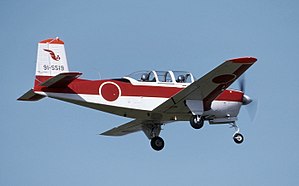Fuji T-3
| T-3 | |
|---|---|

| |
| Fuji T-3 | |
| Role | Primary trainer |
| Manufacturer | Fuji Heavy Industries
|
| First flight | 1978 |
| Status | Active |
| Primary user | Japan Air Self Defense Force
|
| Produced | 1978-1982 |
| Number built | 50 |
| Developed from | Fuji KM-2 |
| Developed into | Fuji T-7 |
The Fuji T-3 is a primary military
Fuji Heavy Industries. Its first flight was in 1978. In the course of its service life, 50 units were produced. It is being replaced by the Fuji T-7
.
Development
The KM-2B was a further development of the
T-34 Mentor with a more powerful engine) for use as a primary trainer for the Japan Air Self-Defense Force (JASDF). It combined the structure and engine of the KM-2 with the tandem cockpit of the T-34 Mentor. Its first flight was on 17 January 1978.[1] Fifty were purchased by the JASDF as the Fuji T-3, and production continued until 1982.[2]
Operational history
The Fuji T-3 served with the 11 and 12 Hiko-Kyoikudan of the JASDF. It is currently being replaced with the Fuji T-7, a turboprop variant of the T-3.[3] with a 400 shp (300 kW) Allison 250 engine.
Operators
Specifications (T-3)
Data from Jane's Aircraft Recognition Guide, Jane's All the World's Aircraft, 1976-1977 [4][5]
General characteristics
- Crew: 2
- Length: 8.04 m (26 ft 5 in)
- Wingspan: 10 m (32 ft 10 in)
- Height: 3.02 m (9 ft 11 in)
- Wing area: 16.5 m2 (178 sq ft)
- Airfoil: root: NACA 23016.5; tip: NACA 23012[6]
- Empty weight: 1,120 kg (2,469 lb)
- Max takeoff weight: 1,510 kg (3,329 lb)
- Powerplant: 1 × piston engine, 254 kW (341 hp)
- Propellers: 3-bladed constant-speed propeller
Performance
- Maximum speed: 377 km/h (234 mph, 204 kn) at 4,875 m (15,994 ft)
- Cruise speed: 254 km/h (158 mph, 137 kn) at 2,440 m (8,005 ft)
- Never exceed speed: 413 km/h (257 mph, 223 kn)
- Range: 1,038 km (645 mi, 560 nmi)
- Service ceiling: 8,170 m (26,800 ft)
- Rate of climb: 7.7 m/s (1,520 ft/min)
- Wing loading: 91.5 kg/m2 (18.7 lb/sq ft)
See also
Related development
Related lists
References
Wikimedia Commons has media related to Fuji T-3.
- ISBN 1-874023-95-6.
- ISBN 1-85605-375-X.
- ISBN 1-85753-245-7.
- ISBN 0-00-470980-2.
- ISBN 0-354-00538-3.
- ^ Lednicer, David. "The Incomplete Guide to Airfoil Usage". m-selig.ae.illinois.edu. Retrieved 16 April 2019.
